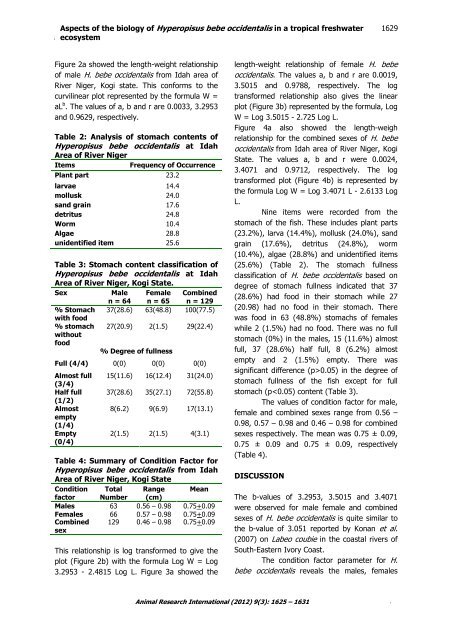3. ADEYEMI.pdf - Zoo-unn.org
3. ADEYEMI.pdf - Zoo-unn.org
3. ADEYEMI.pdf - Zoo-unn.org
You also want an ePaper? Increase the reach of your titles
YUMPU automatically turns print PDFs into web optimized ePapers that Google loves.
Aspects of the biology of Hyperopisus bebe occidentalis in a tropical freshwater<br />
Animal Research International (2012) 9(3): 1625 – 1631 1625<br />
ecosystem<br />
1629<br />
Figure 2a showed the length-weight relationship<br />
of male H. bebe occidentalis from Idah area of<br />
River Niger, Kogi state. This conforms to the<br />
curvilinear plot represented by the formula W =<br />
aL b . The values of a, b and r are 0.0033, <strong>3.</strong>2953<br />
and 0.9629, respectively.<br />
Table 2: Analysis of stomach contents of<br />
Hyperopisus bebe occidentalis at Idah<br />
Area of River Niger<br />
Items<br />
Frequency of Occurrence<br />
Plant part 2<strong>3.</strong>2<br />
larvae 14.4<br />
mollusk 24.0<br />
sand grain 17.6<br />
detritus 24.8<br />
Worm 10.4<br />
Algae 28.8<br />
unidentified item 25.6<br />
Table 3: Stomach content classification of<br />
Hyperopisus bebe occidentalis at Idah<br />
Area of River Niger, Kogi State.<br />
Sex<br />
Male<br />
n = 64<br />
Female<br />
n = 65<br />
Combined<br />
n = 129<br />
% Stomach 37(28.6) 63(48.8) 100(77.5)<br />
with food<br />
% stomach 27(20.9) 2(1.5) 29(22.4)<br />
without<br />
food<br />
% Degree of fullness<br />
Full (4/4) 0(0) 0(0) 0(0)<br />
Almost full<br />
(3/4)<br />
Half full<br />
(1/2)<br />
Almost<br />
empty<br />
(1/4)<br />
Empty<br />
(0/4)<br />
15(11.6) 16(12.4) 31(24.0)<br />
37(28.6) 35(27.1) 72(55.8)<br />
8(6.2) 9(6.9) 17(1<strong>3.</strong>1)<br />
2(1.5) 2(1.5) 4(<strong>3.</strong>1)<br />
Table 4: Summary of Condition Factor for<br />
Hyperopisus bebe occidentalis from Idah<br />
Area of River Niger, Kogi State<br />
Condition Total Range Mean<br />
factor Number (cm)<br />
Males 63 0.56 – 0.98 0.75+0.09<br />
Females 66 0.57 – 0.98 0.75+0.09<br />
Combined<br />
sex<br />
129 0.46 – 0.98 0.75+0.09<br />
This relationship is log transformed to give the<br />
plot (Figure 2b) with the formula Log W = Log<br />
<strong>3.</strong>2953 - 2.4815 Log L. Figure 3a showed the<br />
length-weight relationship of female H. bebe<br />
occidentalis. The values a, b and r are 0.0019,<br />
<strong>3.</strong>5015 and 0.9788, respectively. The log<br />
transformed relationship also gives the linear<br />
plot (Figure 3b) represented by the formula, Log<br />
W = Log <strong>3.</strong>5015 - 2.725 Log L.<br />
Figure 4a also showed the length-weigh<br />
relationship for the combined sexes of H. bebe<br />
occidentalis from Idah area of River Niger, Kogi<br />
State. The values a, b and r were 0.0024,<br />
<strong>3.</strong>4071 and 0.9712, respectively. The log<br />
transformed plot (Figure 4b) is represented by<br />
the formula Log W = Log <strong>3.</strong>4071 L - 2.6133 Log<br />
L.<br />
Nine items were recorded from the<br />
stomach of the fish. These includes plant parts<br />
(2<strong>3.</strong>2%), larva (14.4%), mollusk (24.0%), sand<br />
grain (17.6%), detritus (24.8%), worm<br />
(10.4%), algae (28.8%) and unidentified items<br />
(25.6%) (Table 2). The stomach fullness<br />
classification of H. bebe occidentalis based on<br />
degree of stomach fullness indicated that 37<br />
(28.6%) had food in their stomach while 27<br />
(20.98) had no food in their stomach. There<br />
was food in 63 (48.8%) stomachs of females<br />
while 2 (1.5%) had no food. There was no full<br />
stomach (0%) in the males, 15 (11.6%) almost<br />
full, 37 (28.6%) half full, 8 (6.2%) almost<br />
empty and 2 (1.5%) empty. There was<br />
significant difference (p>0.05) in the degree of<br />
stomach fullness of the fish except for full<br />
stomach (p

















